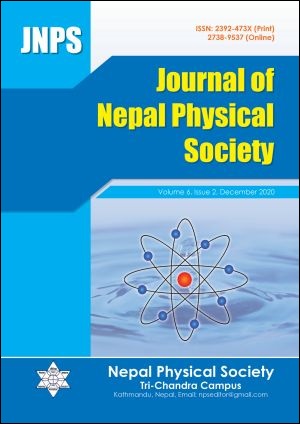Wavelet and Cross-Correlation Analysis of Relativistic Electron Flux with Sunspot Number, Solar Flux, and Solar Wind Parameters
DOI:
https://doi.org/10.3126/jnphyssoc.v6i2.34865Keywords:
Continuous Wavelet Transform, Cross-Correlation, Solar Wind Parameters, Sunspot Number, Relativistic Electron FluxAbstract
The Geostationary Operational Environmental Satellites (GOES) have been monitoring the Earth's radiation environment and is providing the electron flux data (of energy >0.8 MeV, >2 MeV, and >4 MeV) by means of a connected sensor subsystem. Relativistic electron flux is one of the components of the radiation belt which not only affects the electrical system in satellites but also has an impact on Earth’s upper atmospheric climatic variation. We have carried out a study to determine the relation of sunspot number (R), solar flux (F10.7), and solar wind parameters i.e., solar wind velocity (Vsw), plasma density Nsw), the southern component of the interplanetary magnetic field (IMF-Bz), Plasma temperature (Tsw) with relativistic electron flux of energy >0.8 MeV, >2 MeV, and >4 MeV in outer radiation belt using the data of 24 years (1996-2020) covering solar cycle 23 and 24. Time series analysis, Cross-correlation and wavelet analysis techniques have been used in this study. The time series plot displayed that the radiation is occupied mostly by electron flux of energy less than 4 Mev and solar cycle 23 (1996-2008) was strong to produce more intensity of relativistic electron flux of all energy in comparison to cycle 24 (2008-2019). Results from cross-correlation analysis illustrated that Bz has no significant impact on the enhancement of relativistic electron flux of any energy range in the radiation belt. Whereas other studied parameters have a positive correlation with relativistic electron flux, but with significantly different coefficient values for different energy. We found that electron flux >0.8 MeV and >2 MeV has a strong positive association with sunspot number, solar flux, solar wind velocity, plasma density and temperature whereas weak correlation with electron flux of energy >4 MeV. This result leads us to conclude that solar activity and solar parameters have greater influence in producing relativistic electron flux of energy ~ 0.8-4 MeV, than of flux > 4 MeV. The study made to observe the distribution of relativistic electrons in radiation belt with time through continuous wavelet analysis showed that electron flux of energy >0.8 has a higher periodicity in comparison to the flux of other energy ranger.
Downloads
Downloads
Published
How to Cite
Issue
Section
License
All right reserved. No part of this Journal may be reproduced in any form or by any electronic or mechanical means, including information storage and retrieval system, without permission in writing from the publisher, except by a reviewer who may quote brief passage in a review. The views and interpretation in this journal are those of author(s) and they are not attributable to the NPS.




